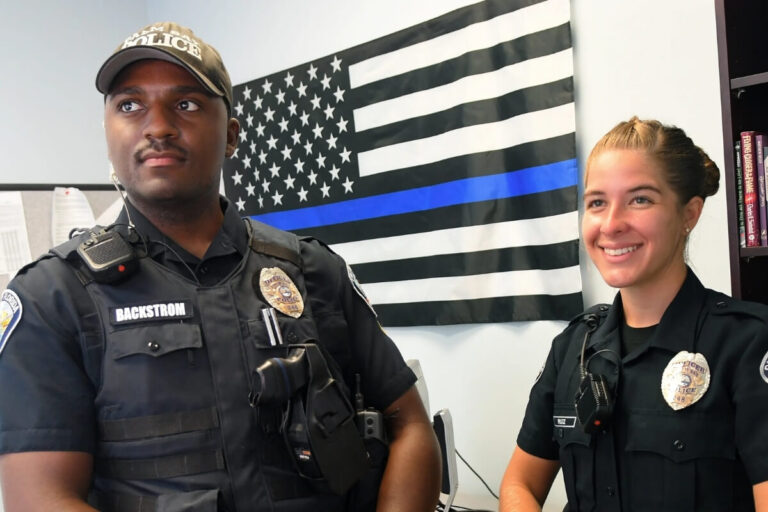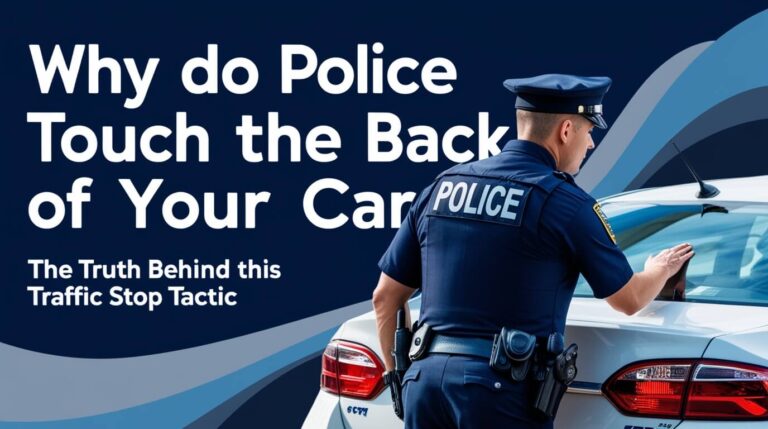Police Uniform: History, Features & Modern Designs
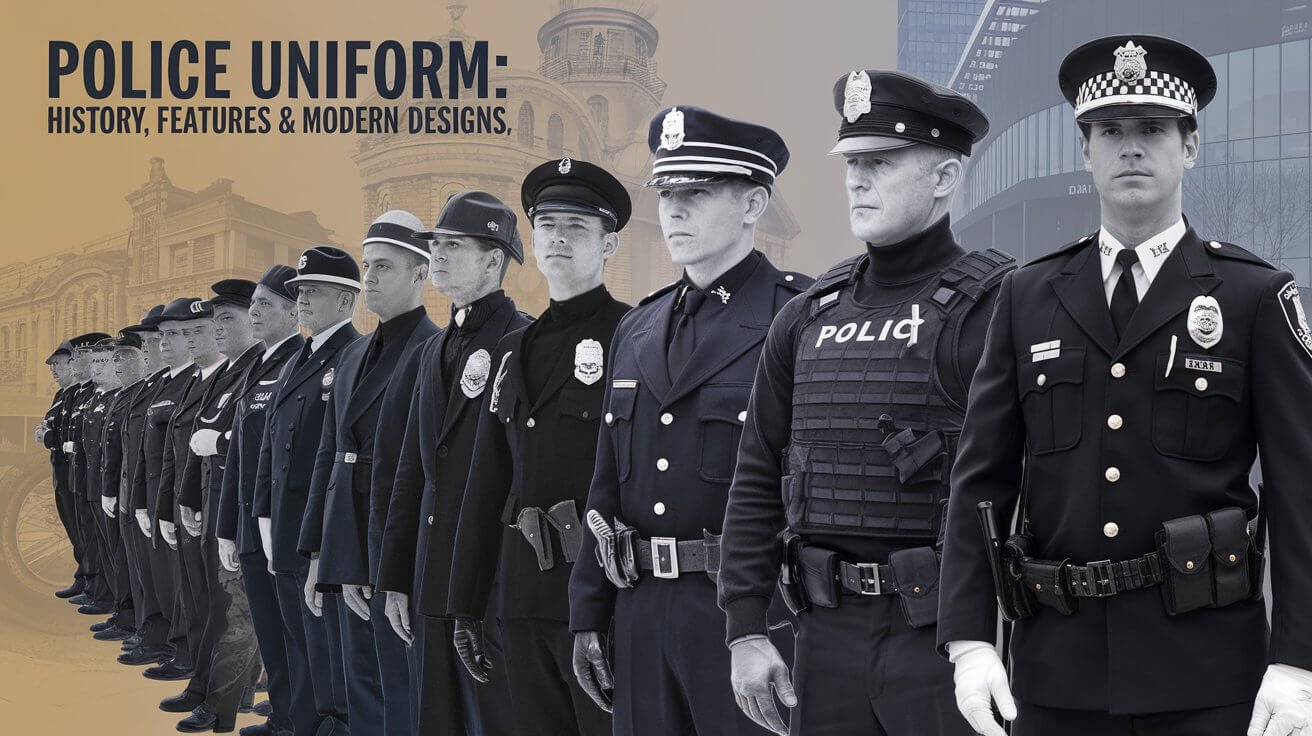
Law enforcement officers in the United States wear uniforms that fall into three classes: Class A, Class B, and Class C. These classes help decide what officers wear for different tasks. For example, Class A uniforms are for formal events, while Class B is for everyday work.
The police uniform is key to showing authority and professionalism. It comes in various styles, with a traditional dark blue or black color. This color choice has roots in military uniforms.
Class A uniforms include blazers and dress slacks. Class B uniforms are made of poly/cotton ripstop or twill. Camouflage uniforms are rare, mainly used by SWAT teams.
Knowing about police uniforms is vital for officers. In this article, we’ll explore the materials, designs, and rules for police uniforms. We’ll also look at the police uniform and law enforcement attire.
Materials and Fabric Technology in Modern Police Attire
Modern police uniforms have changed a lot in terms of materials and fabric tech. They now include tactical gear and police equipment. This change has made uniforms more comfortable, durable, and functional.
Ripstop fabric is a key material for police uniforms. It’s tough and doesn’t tear easily. This makes it perfect for police work.
Moisture-wicking fabrics help officers stay cool and dry. Weather-resistant features keep the uniform working well in different weather. Brands like Blauer have helped improve fabric tech for police uniforms.
Polyester and nylon blends are also popular. They’re comfy, don’t wrinkle or fade much.
Ripstop Fabric Benefits
Ripstop fabric is great for police uniforms because it’s very durable. It’s woven in a special way that stops tears from spreading. This makes it a top choice for police uniforms.
- Exceptional durability and resistance to tears
- Comfortable to wear
- Easy to maintain and clean
Moisture-Wicking Properties
Moisture-wicking fabrics are key for keeping officers cool and dry. They pull sweat away from the skin. This helps officers stay comfortable and focused.
- Keeps officers cool and dry
- Enhances comfort and reduces fatigue
- Improves overall performance
| Fabric Type | Benefits |
|---|---|
| Ripstop Fabric | Exceptional durability and resistance to tears |
| Polyester and Nylon Blends | Comfort, resistance to wrinkling, and fading |
| Moisture-Wicking Fabric | Keeps officers cool and dry, enhances comfort and reduces fatigue |
Color Standards and Department Specifications
Police uniforms are key in law enforcement. Color standards help identify officers and show which department they belong to. Uniform rules ensure everyone looks professional and consistent.
The Office of Mental Health (OMH) gives uniforms to Safety and Security Officers. These uniforms help officers be seen and look professional.
Propper outlines important rules for uniforms. These include wearing navy or dark blue and using poly/cotton blend shirts. Uniforms must be clean and pressed. There are also rules for ballistic panels and vests.
Some important parts of police uniforms include: * Uniform colors and fabrics * Departmental badges and insignia * External ballistic vest carriers and accessories * Uniform care and maintenance
These parts are key to a police officer’s professional image and public trust. Following uniform rules helps officers look united and safe in their work.
| Uniform Component | Specification |
|---|---|
| Uniform Color | Navy or Dark Blue |
| Shirt Fabric | Poly/Cotton Blend |
| External Ballistic Vest Carriers | Departmental Badge, Officer Name, and ID Number |
Essential Components of Police Uniform Design
Police uniforms need to balance function, comfort, and look. They must help officers do their jobs well. The design is key, as it must hold tools and look professional. Flying Cross says shirts and pants are vital in police uniform design.
A good uniform includes tactical gear like vests, belts, and holsters. These items help officers stay safe and work well. For example, vests spread weight evenly to avoid strain. Belts make it easy to get to important tools quickly.
Key Components of Police Uniforms
- Tactical shirts and pants made from durable fabrics designed to withstand significant wear and tear
- Tactical vests providing evenly distributed weight across shoulders and backs to prevent strain
- Duty belts designed for easy access to essential tools, ensuring a quick response in critical situations
- Police badges and insignia to indicate an officer’s position, location, rank, and duty
Adding these key parts to police uniforms is important for safety and work. Knowing about police uniform design and tactical gear helps law enforcement. It ensures officers can do their jobs safely and well.
Seasonal Uniform Variations
Police officers need uniforms that change with the seasons. They wear everything from winter jackets to summer shorts. This helps them stay comfortable and do their job well, no matter the weather.
Blauer, a top maker of police uniforms, offers gear for all seasons. Winter uniforms keep officers warm and dry. Summer uniforms are light and let air in.
Seasonal uniforms are key for officer safety and performance. They prevent heat and cold sickness. This lets officers handle emergencies better and work more easily.
Some important features of seasonal uniforms include:
- Moisture-wicking properties to keep officers dry and comfortable
- Weather-resistant materials to protect against wind, rain, and snow
- Adjustable cuffs and hem to ensure a secure fit
- Reflective strips to increase visibility in low-light conditions
Seasonal uniforms are vital for police. They help officers adjust to weather changes and do their job safely. These uniforms are essential for supporting law enforcement.
| Season | Uniform Features |
|---|---|
| Winter | Thermal insulation, waterproof materials, adjustable cuffs and hem |
| Summer | Lightweight and breathable fabrics, moisture-wicking properties, reflective strips |
Body Armor and Protective Elements
Body armor is key for police, giving them protection from bullets. Propper says most crimes use 9mm weapons. So, Level II vests are enough for most police work.
Police wear body armor to stay safe. It has special systems to prevent injuries. For example, a Level III soft armor vest can stop serious wounds in risky situations.
Types of Body Armor
- Ballistic-resistant flexible armor, which protects against handguns
- Stab-resistant armor, which protects against edged and spike weapons
- Level II, III, and IV armor, which provides varying levels of protection against different types of ammunition
Police uniforms with NIJ-compliant armor offer great protection. Covert ballistic clothing, like the Hidden Defender, is also popular. It’s hard to spot but offers strong protection. Good body armor and gear keep officers safe.
Rank Indicators and Department Insignias
Police insignias and rank indicators are key parts of a police officer’s uniform. They show their authority, rank, and department. Every police officer has the same legal power, no matter their rank. But, a corporal’s role can vary by department.
These insignias help identify officers and show their rank and department. For example, the three-stripe sergeant rank is common. It marks the first level of supervision. Most departments use a single lieutenant rank, shown by gold or silver bars, with silver being higher.
Some important rank indicators and department insignias include:
- Corporal: carries supervisory authority, but not universal across departments
- Sergeant: three-stripe rank, represents the first line of supervision
- Lieutenant: universal rank, gold or silver bars, with silver being higher
- Captain: typically the highest achieved through competitive civil service process
It’s vital for police officers to know the importance of rank indicators and department insignias. Wearing the right insignias shows their pride and dedication. It also clearly shows their authority and rank.
Proper Uniform Measurements and Sizing
Police officers need uniforms that fit right and work well. Getting the right measurements and sizing is key for looking professional and performing well. Blauer’s guidelines offer charts to help officers get their measurements right.
For example, chest width and neck size are key for uniform shirts. Here’s a table that shows these measurements for short sleeve shirts:
| Size | Chest Width | Neck Size | Length |
|---|---|---|---|
| Small | 19 inches | 14/14.5 inches | 29 inches |
| Medium | 21.5 inches | 15/15.5 inches | 30 inches |
| Large | 23 inches | 16/16.5 inches | 31 inches |
| Extra Large | 25 inches | 17/17.5 inches | 32 inches |
Upper Body Measurements
Getting your upper body measurements right is important for a good fit. Make sure to measure your chest, neck, and sleeve length. This ensures your uniform looks and feels great.
Lower Body Specifications
Lower body measurements, like pant length and waist size, are also critical. Use the sizing charts to make sure your uniform fits perfectly.
Alterations Guidelines
At times, you might need to make some adjustments for the perfect fit. Always follow the guidelines from your uniform’s maker or department. This way, your uniform will meet all the standards.
Footwear and Duty Boot Standards
Police footwear is key for a police officer’s uniform. It gives the needed support and protection for their feet. There are many types of police footwear, ensuring officers have both function and comfort. Most duty boots weigh under 25 ounces, making them easier to wear.
There are patrol boots, mid boots, and motorcycle unit boots. Patrol boots are about 8 inches tall. Mid boots are 5-6 inches. Motorcycle boots need a shaft of up to 17 inches for extra protection.
When picking police footwear, look for:
- Slip and abrasion-resistant rubber outsoles for durability
- Insulation, such as Thinsulate, for cold weather
- Safety toe options, like steel or synthetic
- Waterproof or mesh materials for wet or warm weather
Officers should follow their department’s guidelines for footwear. This ensures they meet standards for different uniform classes. The right footwear helps officers do their job safely and look professional.
| Uniform Class | Footwear Recommendations |
|---|---|
| Class A | High-shine poromeric footwear for special occasions, slip and abrasion-resistant rubber outsoles for daily duties |
| Class B | Slip-proof attributes, for outdoor work in rain |
| Class C | Protective and flexible boots, with waterproof or mesh options |
Understanding police footwear and duty boots helps officers choose wisely. They ensure they meet uniform class and department standards. Duty boots, like those from Propper, are vital for police officers’ support and protection.
Equipment Belt and Attachment Systems
A well-designed equipment belt is key for police officers to do their jobs well. It holds holsters, flashlights, and first aid kits. A good belt is comfy, lasts long, and makes gear easy to get to.
Flying Cross says where you put the holster matters a lot. It should make drawing and putting away the gun easy. The belt also needs to spread out the weight of the gear so officers don’t get tired or uncomfortable.
Key Considerations for Equipment Belts
- Material: The belt should be made from high-quality, durable materials that can withstand the rigors of daily use.
- Adjustability: The belt should be adjustable to fit different waist sizes and provide a secure fit.
- Attachment systems: The belt should have a reliable attachment system for securing gear and tools.
TYR Tactical makes top-notch equipment belts for law enforcement. Their belts are tough, adjustable, and have strong attachment systems. With a quality belt and system, officers can carry the right tools safely and efficiently.
Care and Maintenance Protocols
Keeping police uniforms in top shape is key to their longevity. Blauer, a top maker of police uniforms, says regular care is vital. This means washing and drying as the maker suggests, and ironing to keep it looking sharp.
Good care means cleaning, storing, and checking the uniform often. This stops damage, fading, and wear. By doing this, uniforms stay in great shape. This makes the department and the officer look good.
Some important steps for police uniform care include:
- Washing and drying the uniform according to the manufacturer’s instructions
- Ironing and pressing to maintain a neat and professional appearance
- Regular inspection of the uniform to identify and repair any damage
- Proper storage of the uniform to prevent creasing and damage
Sticking to these care steps, officers keep their uniforms looking good. This shows well on the department and the officer. So, caring for police uniforms is a must for all officers.
| Uniform Component | Maintenance Protocol |
|---|---|
| Shirt and Pants | Wash and dry according to manufacturer’s instructions |
| Tactical Vest | Regularly inspect and clean to prevent damage |
| Badge and Insignia | Polish and clean regularly to maintain appearance |
Department-Specific Uniform Regulations
Police officers must follow specific rules set by their department. These rules make sure their uniforms are both right and professional. It’s key for officers to know federal, state, and local policies to look professional.
Uniform rules differ by department, but most follow federal guidelines. Propper, a top maker of police uniforms, says federal rules are a base for department rules. These rules cover things like fabric, color, and design.
Federal Guidelines
Federal rules set a framework for department-specific uniform rules. They help keep departments consistent and provide a base for state and local rules.
State-Level Requirements
State rules add to federal guidelines, with more details for police uniforms. They might include specific colors, fabrics, or designs for each state.
Local Department Policies
Local policies are made for each department’s needs. They might include rules on uniforms, badge placement, and equipment. Following these policies helps officers meet department standards.
Department-specific uniform rules are key for a professional look and following rules. By knowing and following these rules, police officers can focus on their jobs, knowing their uniform is up to standard.
| Level | Guidelines | Purpose |
|---|---|---|
| Federal | Provide a framework for uniform regulations | Ensure consistency across departments |
| State | Build upon federal guidelines, providing additional specifications | Meet the specific needs of each state |
| Local | Tailored to meet the specific needs of each department | Ensure compliance with department-specific guidelines |
Bottom Line
The police uniform is key to law enforcement, showing authority, professionalism, and trust in the community. It uses advanced fabrics for better performance and follows strict rules for its design. This makes police uniforms essential for officers every day.
Details like badge placement and seasonal changes are thought out carefully. Each part of the uniform is made to meet high standards. This is important as people’s views on police change.
The uniform’s role in showing respect and authority is clear. As the uniform industry grows, officers and departments must keep up. They need uniforms that are comfortable, work well, and look professional.
This helps build trust with the public. It shows that police are competent and honest. This is vital for good community policing.
Popular Questions
What are the different types of police uniforms?
Police uniforms come in three main types: Class A, Class B, and tactical. Each has its own design and features.
What materials are used in modern police uniforms?
Modern police uniforms use advanced materials. These include ripstop fabric for durability and moisture-wicking properties for comfort.
How do color standards and department specifications affect police uniforms?
Color standards and department rules are key. They help make police uniforms look professional and unique to each agency.
What are the essential components of police uniform design?
Important design parts include the shirt and pants, tactical vests, and badge placement. These must be functional, comfortable, and professional.
How do police officers adapt their uniforms to seasonal changes?
Police departments offer different uniforms for each season. This includes winter jackets and summer shorts for comfort in all weather.
What protective features are included in police uniforms?
Police uniforms have body armor and other safety features. These include bulletproof vests and systems to protect against impacts.
How are rank and department indicators displayed on police uniforms?
Rank and department insignias are key. They help identify officers and their roles within the police hierarchy.
How are police uniform measurements and sizing determined?
Uniform measurements are critical. They ensure a good fit for each officer, making the uniform comfortable and functional.
What are the standards for police footwear and duty boots?
Footwear and duty boots must meet strict standards. They provide support and protection for officers’ feet during work.
How do equipment belts and attachment systems integrate with police uniforms?
Equipment belts and systems help officers carry tools. They consider holster placement and weight balance for ease of use.
What are the care and maintenance protocols for police uniforms?
Uniform care is vital. It includes cleaning, repair, and storage to keep the uniforms looking professional and lasting longer.
How do department-specific uniform regulations impact police officers?
Officers must follow federal, state, and local rules for uniforms. This ensures they look professional and follow regulations.

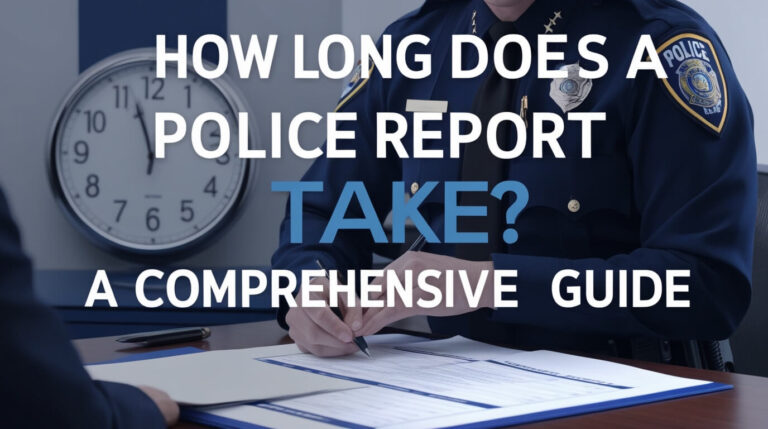
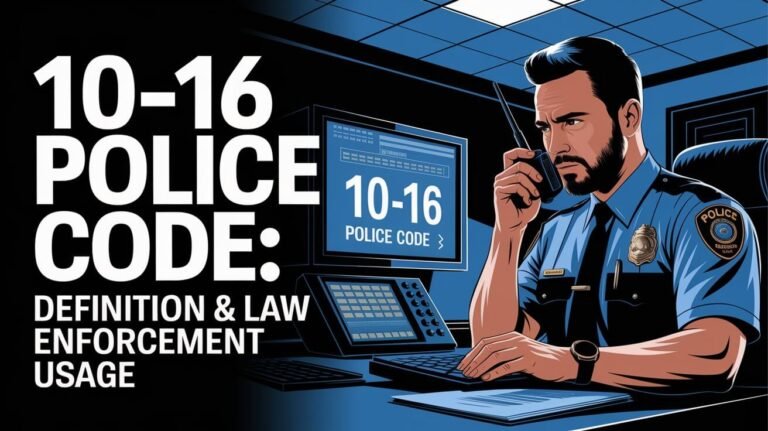
![Police Officer Work Hours: A Comprehensive Guide [2024] 4 Police Officer Work Hours](https://policepathfinder.com/wp-content/uploads/2024/10/police-officer-work-hours-768x431.jpeg)

